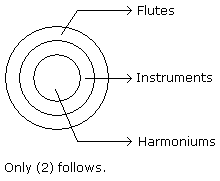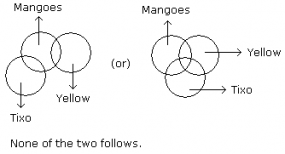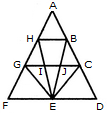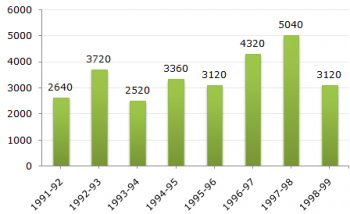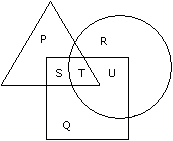 Introduction
Introduction
RRB NTPC (Non-Technical Popular Categories) 2020 – Second Stage Computer Based Test (CBT), conducted in online Mode, has: a duration of 90 minutes [120 Minutes for eligible PwBD candidates accompanied with Scribe], consists of 3 sections, namely – General Awareness, Mathematics and General Intelligence & Reasoning. The 3 sections are not separately timed. There is a Negative marking in RRB NTPC Second Stage CBT and 1/3rd marks are deducted for each wrong answer. The article RRB NTPC Second Stage Model Paper is very useful to know the Model Paper and Sample questions related to the RRB NTPC Second Stage 2020 Exam.
 Pattern
Pattern
| Exam Duration | Mathematics | General Intelligence & Reasoning | General Awareness | Total No. of Questions |
|---|---|---|---|---|
| 90 | 50 | 35 | 35 | 120 |
 Syllabus
Syllabus
 Samples
Samples
1. Former Australian captain Mark Taylor has had several nicknames over his playing career. Which of the following was NOT one of them?
- A. Tubby
B. Stodge
C. Helium Bat
D. Stumpy
- A. Canada
B. Sri Lanka
C. Zimbabwe
D. East Africa
- A. Glamorgan
B. Leicestershire
C. Gloucestershire
D. Lancashire
- A. M.L.Valsamma
B. P.T.Usha
C. Kamaljit Sandhu
D. K.Malleshwari
- A. Karnataka
B. Orissa
C. Kerala
D. Manipur
- A. Ottan Thullal
B. Kuchipudi
C. Yakshagana
D. Odissi
- A. 1911
B. 1913
C. 1936
D. 1935
- A. Uttar Pradesh
B. Rajasthan
C. Madhya Pradesh
D. Bihar
- A. glass
B. water
C.hydrogen
D. vacuum
- A. at sea level
B. at the top of Mt. Everest
C. At a place in a valley below sea level
D. in an aeroplane flying at a height of 10,000 m with inside pressure maintained at the sea level
- A. necessary centrifugal force may be obtained from the horizontal component weight of the train
B. to avoid frictional force between the tracks and wheels
C. necessary centripetal force may be obtained from the horizontal component of the weight of the train
D. the train may not fly off in the opposite direction
- A. Abdulhashim Mutalov
B. Oʻtkir Sultonov
C. Islam Karimov
D. Nigmatilla Yuldashev
- A. Sirikit Kitiyakara
B. Vajiralongkorn
C. Ananda Mahidol
D. Bhumibol Adulyadej
- A. 1990
B. 1991
C. 1992
D. 1993
- A.Pandit Jawaharlal Nehru
B. Lal Bahadur Shastri
C. Gulzar Lal Nanda
D. None of the Above
- A. Annie Besant
B. Acharya Narendra Dev
C. Lal-Bal-Pal
D. None of the above
- A. Rs. 210
B. Rs. 330
C. Rs. 450
D. Rs. 510
- A. 25 years
B. 22 years
C. 18 years
D. 15 years
- A. Rs. 3000
B. Rs. 5000
C. Rs. 7000
D. Rs. 10000
- A. Sabka Saath Sabka Vikas
B. Beti Bachao Beti Padhao
C. Kal ki Fikr Nahin
D. Mera Khata Bhagya Vidhata
- A. One
B. Two
C. Three
D. Equal to the number of girl children
- A. Rs. 12
B. Rs. 15
C. Rs. 18
D. Rs. 20
- A. 2000
B. 2003
C. 2009
D. 2012
- A. 1973
B. 1975
C. 1974
D. 1976
- A. Deomali - Arunachal Pradesh
B. Garo Hills - Meghalaya
C. Mayurbhanj - Chhattisgarh
D. Mysore - Karnataka
- A. Remote
B. Hybrid
C. Analog
D. Digital
- A. Mainframes
B. Laptops
C. Microprocessors
D. Hybrid
- A. personal digital applications
B. private digital applications
C. personal digital assistants
D. private digital assistants
- A. cell
B. empty space
C. record
D. field
- A. CTRL+C, CTRL+V
B. CTRL+C, CTRL+P
C. CTRL+S, CTRL+S
D. SHIFT+C, ALT+P
- A. Mahatma Gandhi
B. Jawaharlal Nehru
C. Subhash Chandra Bose
D. Jayaprakash Narayan
- A. 1946
B. 1939
C. 1942
D. 1940
- A. Jawaharlal Nehru
B. Aruna Asif Ali
C. Mahatma Gandhi
D. Annie Besant
- A. Declaration of Independence
B. Declaration of Constitution
C. Declaration of Constituent Assembly
D. None of the above<
- A. Thiruvalluvar
B. Ayaikar
C. Shankracharya
D. Rishi Agasta
- A. Tolkāppiyam
B. Patinenmēlkanakku
C. Patinenkīlkanakku
D. None of the above
- A. Nanmanikkatiga
B. Naaladiyar
C. Inna Narpathu
D. Iniyavai Narpathu
- A. Only I
B. Only II
C. Both I & II
D. Neither I nor II
- A. Oxygen
B. Hydrogen sulphide
C. Carbon dioxide
D. Nitrogen
- A. Rig Vedas
B. AtharvaVedas
C. Aryankas
D. Upanishad
- A. Graphite
B. Silicon
C. Charcoal
D. Phosphorous
- A. oxygen and hydrogen
B. oxygen, hydrogen, acetylene and nitrogen
C. oxygen, acetylene and argon
D. oxygen and acetylene
- A. osmosis
B. deliquescence
C. efflorescence
D. desiccation
- A. shape
B. area
C. baring
D. distance
- A. zones of climate
B. zones of oceans
C. zones of land
D. zones of cyclonic depressions<
- A. ILO
B. WHO
C. ASEAN
D. All of the above
- A. every 6 months
B. every 3 months
C. every year
D. every month
- A. Dr. Manmohan Singh
B. Farooq Abdullah
C. Dinesh singh
D. Alam Khan
- A. National Highways
B. State Highways
C. Border Roads
D. District Highways
- A. 1948
B. 1949
C. 1950
D. 1951
1.Simplify the expression using BODMAS rule:: ([latex]\frac {3}{2}[/latex]) of ([latex]\frac {4}{7}[/latex]) {(10 × 3) – (8 × 2)}
- A. 6
B. 12
C. 18
D. 14
- A. 0
B. 2
C. 4
D. 3
- A. [latex]\frac {5111}{9000}[/latex]
B. [latex]\frac {6117}{9000}[/latex]
C. [latex]\frac {6119}{9000}[/latex]
D. None of these
- A. 400
B. 900
C. 275
D. None of these
- A. [latex]\frac {8}{9}[/latex]
B. [latex]\frac {18}{23}[/latex]
C. [latex]\frac {13}{21}[/latex]
D. [latex]\frac {14}{17}[/latex]
- A. 100 days
B. 100 days
C. 90 days
D. 75 days
- A. 14.4 days
B. 15.5 days
C. 12 days
D. 20 days
- A. [latex]\frac {17}{11}[/latex]
B. [latex]\frac {13}{11}[/latex]
C. [latex]\frac {13}{2}[/latex]
D. [latex]\frac {17}{2}[/latex]
- A. 31
B. 35
C. 36
D. 41
- A. 53.84%
B. 60%
C. 56.67%
D. 63.84%
- A. Rs. 223080
B. Rs. 223090
C. Rs. 232080
D. Rs. 223880
- A. 80km/hr
B. 120km/hr
C. 160km/hr
D. 50km/hr
- A. 818km
B. 979km
C. 711km
D. 850km
- A. 2:1
B. 1:2
C. 3:1
D. 2:1
- A. I alone sufficient while II alone not sufficient to answer
B. II alone sufficient while I alone not sufficient to answer
C. Either I or II alone sufficient to answer
D. Both I and II are necessary to answer
- A. 630
B. 360
C. 603
D. 306
- A. 123
B. 73
C. 77
D. 154
- A. 31
B. 81
C. 45
D. 21
- A. 846
B. 864
C. 840
D. 876
- A. 159m
B. 179m
C. 147m
D. 153m
- A. 140M
B. 128M
C. 120M
D. 156M
- A. 1800 cm²
B. 1500 cm²
C. 1100 cm²
D. 1600 cm²
- A. [latex]\frac {1}{2}[/latex]
B. [latex]\frac {2}{5}[/latex]
C. [latex]\frac {8}{15}[/latex]
D. [latex]\frac {9}{20}[/latex]
- A. [latex]\frac {1}{2}[/latex]
B. [latex]\frac {3}{4}[/latex]
C. [latex]\frac {3}{8}[/latex]
D. [latex]\frac {5}{16}[/latex]
- A. [latex]\frac {1}{10}[/latex]
B. [latex]\frac {2}{5}[/latex]
C. [latex]\frac {2}{7}[/latex]
D. [latex]\frac {5}{7}[/latex]
- A. [latex]\frac {1}{13}[/latex]
B. [latex]\frac {3}{13}[/latex]
C. [latex]\frac {1}{4}[/latex]
D. [latex]\frac {9}{52}[/latex]
- A. 1
B. 0
C. 2 cos θ
D. 2 sin θ
- A. sin 2B
B. sin B
C. cos 2B
D. cos B
- A. 1
B. -1
C. -2
D. 0
- A. 57%
B. 60%
C. 65%
D. 90%
- A. Rs. 650
B. Rs. 690
C. Rs. 698
D. Rs. 700
- A. Rs. 4462.50
B. Rs. 8032.50
C. Rs. 8900
D. Rs. 8925
- A. 3.6
B. 6
C. 18
D. Cannot be determined
- A. 3
B. 4
C. 6
D. 5
- A. 9600
B. 9800
C. 9500
D.
Answer - Option A
Explanation - Greatest number of 4-digits is 9999.
L.C.M. of 15, 25, 40 and 75 is 600.
On dividing 9999 by 600, the remainder is 399.
Required number (9999 - 399) = 9600.
1. Odometer is to mileage as compass is to
- A. speed
B. hiking
C. needle
D. direction
- A. winter
B. bear
C. dream
D. sleep
- A. read : skim
B. research : learn
C. write : print
D. hink : relate
- A. 35
B. 38
C. 39
D. 40
- A. 143
B. 165
C. 186
D. 209
- A. Only (1) conclusion follows
B. Only (2) conclusion follows
C. Either (1) or (2) follows
D. Neither (1) nor (2) follows
- A. Only (1) conclusion follows
B. Only (1) conclusion follows
C. Either (1) or (2) follows
D. Neither (1) nor (2) follows
- A. i m
B. m i
C. i n
D. j m
- A. eifgi
B. figie
C. ifgie
D. ifige
- A. V X D Q
B. XUGX
C. ROAR
D. VSOV
- A. W e D N e S d A Y
B. W E d n E S d A Y
C. T H U R S d A Y
D. f r I d A Y
- A. 40
B. 28
C. 65
D. 58
- A. 52
B. 25
C. 30
D. 24
- A. Brother
B. Uncle
C. Cousin
D. Father
- A. Brother
B. Sister
C. Nephew
D. Cannot be determined
- A. M - N x C + F
B. F - C + N x M
C. N + M - F x C
D. M x N - C + F
- A. 12
B. 18
C. 11
D. 10
- A. C
B. v D
C. A
D. B
- A. Alfredo's offers fine Italian cuisine and an elegant Tuscan decor. Patrons will feel as though they've spent the evening in a luxurious Italian villa.
B. Pancho's Mexican Buffet is an all-you-can-eat family style smorgasbord with the best tacos in town.
C. The Parisian Bistro is a four-star French restaurant where guests are treated like royalty. Chef Dilbert Olay is famous for his beef bourguignon.
D. Marty's serves delicious, hearty meals in a charming setting reminiscent of a baseball clubhouse in honor of the owner,Marty Lester, a former major league baseball all-star.
- A. A girl is sitting glumly on a bench reading a book and not interacting with her peers.
B. Four girls are surrounding another girl and seem to have possession of her backpack.
C. Four girls are surrounding another girl and seem to have possession of her backpack.
D. Three boys are huddled over a handheld video game, which isn't supposed to be on school grounds.
- A. 2:8
B. 3:5
C. 2:5
D. 3:7
- A. 1:5
B. 0:5
C. 2:54
D. 0:2
- A. 1992-93
B. 1993-94
C. 1994-95
D. 1996-97
- A. 95%
B. 110%
C. 115%
D. 125%
- A. 100
B. 150
C. 200
D. 250
- A. West
B. South
C. North-East
D. South-West
- A. East
B. West
C. South
D. Data inadequate
- A. Brother
B. Brother-in-law
C. Sister-in-law
D. None of these
- A. Sister
B. Niece
C. Cousin
D. None of these
- A. Only I follows
B. Only II follows
C. Either I or II follows
D. Both I and II follow
- A. Only I follows
B. Only II follows
C. Either I or II follows
D. Neither I nor II follows
- A. U
B. T
C. S
D. P
- A. CBT
B. ABR
C. BCT
D. RBB
- A. N
B. E
C. Y
D. R
- A. LVMEZOD
B. NTCOMBF
C. NTOCNBF
D. LTMCZOF




